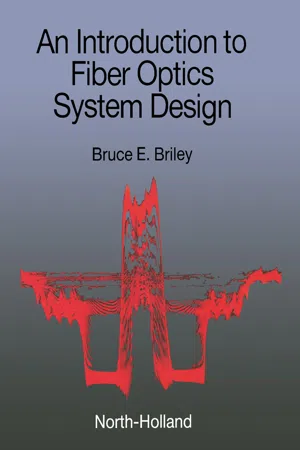
- 352 pages
- English
- PDF
- Available on iOS & Android
An Introduction to Fiber Optics System Design
About This Book
A thorough account on the basics of fiber optics system design is contained in this volume. Introducing the topics from the vantage point of the student and professional electrical engineer, the aim of the text is to teach rather than merely present facts. The overall view of the text is toward practical engineering considerations including costs, and a discussion of radiation effects is associated with each appropriate chapter.The volume begins with a history of optical communications, leading to the now widely practiced field of fiber optics. Comparisons are made to conventional media and techniques: wire-line, coaxial cable, and radio. The nature and properties of optical fiber are examined, including manufacturing techniques, and fiber types and capabilities. The theory of light guidance is introduced in steps, beginning with a slab waveguide. Solutions of Maxwell's equations are derived and explained in view of the peculiar nature of the medium. Electro-optic devices are examined, including launching and detecting devices. The properties and varieties of these devices are explored. In particular, light-emitting diodes, injection laser diodes, p-i-n diodes, and avalanche photo diodes are covered. The electronic circuits necessary to adequately serve the electro-optic devices are examined and contrasted with more conventional types.Modulation techniques appropriate to optical fiber transmission systems are enumerated and compared. Overall system considerations are addressed, and examples are given of various systems that have been deployed, or are planned for deployment. Expectations for future developments and trends in the field are enumerated, with indications of their significance. Topics such as ultra-low-loss fiber and coherent detections techniques are discussed.Appendices comprising an accounting of useful laboratory equipment, mathematical relations employed in the body of the text, and complete exercise solutions are included.
Frequently asked questions
Information
Table of contents
- Front Cover
- An Introduction to Fiber Optics System Design
- Copyright Page
- Table of Contents
- Dedication
- PREFACE
- ILLUSTRATIONS LIST
- CHAPTER 1. INTRODUCTION TO FIBER OPTICS
- CHAPTER 2. OPTICAL FIBER
- CHAPTERS 3. ELECTRO-OPTICAL CONVERSION DEVICES
- CHAPTER 4. CIRCUITS: TRANSMITTING AND RECEIVING
- CHAPTER 5. MODULATION TECHNIQUES
- CHAPTER 6. SYSTEMS
- CHAPTER 7. FUTURES
- APPENDIX A: APPARATUS AND INSTRUMENTATION
- APPENDIX B: USEFUL RELATIONS
- APPENDIX C: EXERCISE SOLUTIONS
- GLOSSARY
- BIBLIOGRAPHY
- INDEX